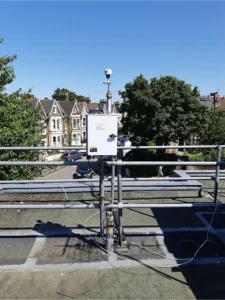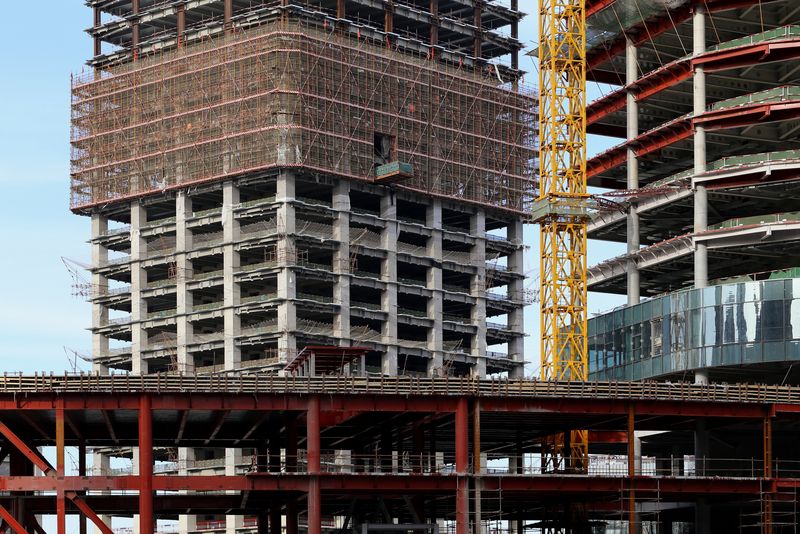How Construction Affects Air Quality, & Ways to Reduce Its Impact
05-02-2025
Understanding the Impact of Construction on Air Quality
How Does Construction Affect Air Quality?
Poor management of construction activities and operations can lead to elevated concentrations of air pollutants such as particulate matter, which in turn can lead to dust soiling in the local area. This can potentially lead to regulatory enforcement and to the exposure of nearby receptors (e.g. local residents) to unacceptable levels of air pollution.
Key ways construction impacts air quality
Air quality is potentially affected in two main ways by construction activities.
- Firstly, construction dust emissions can increase airborne particulate matter concentrations and dust soiling. The former has potential health implications for the local population, and the latter can impact residential dwellings and local businesses through the deposition/settlement of dust on surfaces. Some ecological sites/habitats are also sensitive to particulate emissions, particularly dust soiling.
- Secondly, combustion emissions from site plant, tools, generators and vehicles can impact local air quality by increasing particulate matter and nitrogen dioxide concentrations.
What are the Main Sources of Air Pollution in Construction?
Various construction activities can, if not managed effectively, lead to dust and other air pollutant emissions, including demolition works, piling, the movement and storage of dry/dusty materials (e.g., sand and cement), the operation of tools and site plant (e.g., grinders, saws and diesel generators) and Non-Road Mobile Machinery (e.g., diggers). The movement of heavy vehicles on and off-site can also lead to the trackout of mud/dusty materials onto the public highway.
What construction materials and practices contribute most to air pollution?
If not managed effectively, various construction materials and practices can lead to dust and other air pollution emissions. Emissions due to demolition works, piling, the movement and storage of dry/dusty materials, the operation of tools, site plant and Non-Road Mobile Machinery can all potentially affect local air quality. The movement of heavy vehicles on and off-site can also lead to the trackout of mud/dusty materials onto the public highway.
What are the health risks associated with poor air quality on construction sites?
Emissions of dust from a construction site can increase concentrations of particulate matter in the local area. Fine particulate matter, known as PM10, can have adverse human health effects and is a regulated air pollutant in the UK.

Why is Air Quality Monitoring Important in Construction Zones?
Air quality monitoring is important to demonstrate to local regulators and those living and working near a construction site that site activities and emissions are effectively managed. Real-time air quality monitoring and an effective alerting system can help construction site operatives respond to adverse air quality events, allowing for rapid modification to site operations or the deployment of enhanced mitigation measures to better control emissions.
Practical Steps to Reduce Air Pollution on Construction Sites
The main principles for preventing and minimising dust emissions at construction sites are:
- Avoiding dust (e.g., wetting down of materials in dry and/or windy conditions).
- The containment of dust (e.g., erecting barriers and/or screens around the site boundary and/or stockpiles of materials).
- The suppression of dust (e.g., the re-vegetation of earthworks and/or exposed areas or using Hessian or mulches to cover topsoil).
Combustion emissions from construction plant, tools and vehicles can be minimised by using equipment appropriate for the task at hand (i.e. equipment that is correctly rated for the activity and fitted with appropriate emissions controls) and by employing robust equipment servicing and maintenance protocols.
How can we minimise the environmental impact of construction?
The impact of construction activities on local air quality can be minimised by having due regard to weather conditions that might be conducive to dust generation and by adopting the hierarchy of avoidance, containment and suppression of site emissions. The use and ongoing maintenance of the most-up-to date construction equipment also has its advantages, along with air quality monitoring to check compliance with any local regulations and to assess the effectiveness of any mitigation measures employed on site.
How to Use Green Building Materials Effectively
Sustainable construction materials can have ongoing benefits for the occupants of buildings and the wider environment. For example, the use of non-toxic and low-VOC (volatile organic compound) materials can reduce the exposure of building occupants to potentially harmful pollutants present in some furniture, finishings and materials used in homes and offices. The use of recycled, renewable and low-embodied carbon materials can help reduce carbon and other emissions associated with the production and use of resources in the construction industry.
What are the Benefits of Upgrading Construction Machinery?
Using the most up-to-date machinery/equipment on a construction project should help ensure that emissions performance/controls are effective and that the work can be completed in the most efficient manner. It’s important that all Non-Road Mobile Machinery meets relevant emissions requirements for the local area, such as the Low Emission Zone for Non-Road Mobile Machinery in London, and that on-road vehicles accessing the site also meet any Clean Air Zone or Low Emission Zone requirements for the site location.
Innovative Technologies for Air Quality Control
What new technologies are available to monitor and control air pollution?
The emergence of ‘low-cost’ air quality sensor technologies has enabled cheaper air quality monitoring devices to come to market. These provide the same types of measurement as traditional’ Continuous Monitoring Systems (CMS), but often at improved temporal resolution and at lower power consumption. MCERTs certification for indicative particulate matter measurements now allows some ‘low-cost’ sensor options to be utilised on construction projects to evaluate airborne dust emissions.
When coupled with an effective alerting system, ‘low cost’ sensor options can help construction site operatives respond to adverse air quality events, allowing for rapid modification to site operations or the deployment of enhanced mitigation measures to better control emissions.
Regulations and Standards for Pollution Control in Construction
Construction sites are usually consented and regulated by the relevant local authority, and construction air quality impacts are often controlled through the implementation of Construction Environmental Management Plans (CEMPs) or Air Quality and Dust Management Plans (AQDMPs), which are developed and agreed through planning or post-planning mechanisms. Some developers may choose to sign up to programmes such as the Considerate Constructors Scheme, which promotes best-practice and high standards in the construction industry.
If construction activities cause nuisance in the local area due to dust emissions, the local authority can restrict or even stop site operations. Restrictions may be placed on the type of plant or machinery that can be used on site and the hours when works can take place. ‘Trigger’ and ‘action’ levels for particulate matter concentrations can also be imposed and are usually verified through ongoing monitoring of air quality on the construction site boundary and/or at identified sensitive locations.
How Can Targeted Monitoring Solutions Improve Air Quality?
Air quality monitoring on a construction site boundary and/or at sensitive receptor locations is important to demonstrate to local regulators and those living and working near a construction site that site activities and emissions are being effectively managed. Real-time air quality monitoring, coupled with an effective alerting system, can help construction site operatives respond to adverse air quality events, allowing for rapid modification to site operations or the deployment of enhanced mitigation measures to better control emissions.
What are examples of targeted air quality monitoring solutions?
Air quality monitoring can help construction site operatives respond to adverse air quality events, allowing for rapid modification to site operations or the deployment of enhanced mitigation measures to better control emissions. Trigger’ and ‘action’ levels for particulate matter concentrations can be imposed and are usually verified through ongoing monitoring of air quality on the construction site boundary and/or at identified sensitive locations.

Indoor Air Quality in the Built Environment
How Does Construction Impact Indoor Air Quality?
Indoor air quality is affected by sources of emissions outside of a property that ingress through ventilation systems, windows and doors, and also by sources located inside a property e.g. materials, finishes and furnishings, and combustion sources such as gas boilers and kitchen hobs.
How does construction influence indoor air quality in buildings?
Construction emissions, including dust/particulates, can potentially impact on the quality of air inside neighbouring properties via the ingress of pollution from outside to inside and also by the use of certain materials (e.g. vinyl flooring) and products (e.g. glues, paints etc) inside a property during construction.
Improving Ventilation and Indoor Air Quality Post-Construction
Post-construction purging of air inside a property can be important to remove volatile organic compounds (VOCs) that may be present due to off-gassing from VOC-containing materials such as vinyl flooring, glues, paints and other finishing products.
What role does ventilation play in managing indoor air quality?
In areas of poor air quality, it may be necessary to install particulate matter and/or NOx filters to mechanical ventilation systems or, through development design processes, to ensure that more sensitive uses (e.g. living rooms and bedrooms) are located as far away from sources of emissions (e.g. roads) as possible.
What Materials Affect Indoor Air Quality?
Materials that affect indoor air quality the most are VOC-containing materials such as vinyl flooring, glues, paints and other finishing products.
How can sustainable materials mitigate indoor air pollution?
The use of non-toxic and low-VOC (volatile organic compound) materials can reduce the exposure of building occupants to potentially harmful pollutants present in some furniture, finishings and materials used in homes and offices.
Emerging Trends in Sustainable Construction Practices
One key trend is the increasing focus on net-zero buildings that are not only carbon-neutral, but are climate resilient and use alternative (greener) building materials.
What Is the Future of Air Quality Management in Construction?
‘Low-cost’ air quality sensors coupled with real-time alerting and reporting functionality can provide high temporal resolution air quality monitoring data and enable site contractors to react to adverse air quality events more quickly and effectively and to better communicate to stakeholders the impacts of construction emissions on the local community.
Success Stories in Minimising Construction Air Pollution
Phlorum’s air quality consultants have provided construction-specific air quality services to numerous developers and contractors in London and the south-east of England.
This includes undertaking construction air quality assessments for planning, the production of Air Quality and Dust Management Plans (AQDMPs) to assist in the discharge of construction-related planning conditions, and the design and implementation of air quality monitoring programmes using real-time monitoring devices, dust deposition gauges and diffusion tubes.



